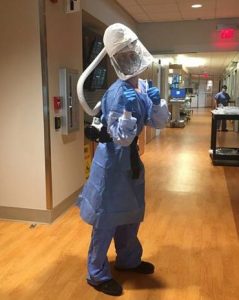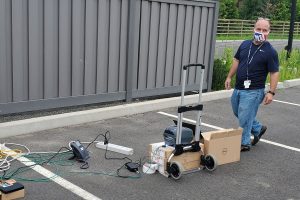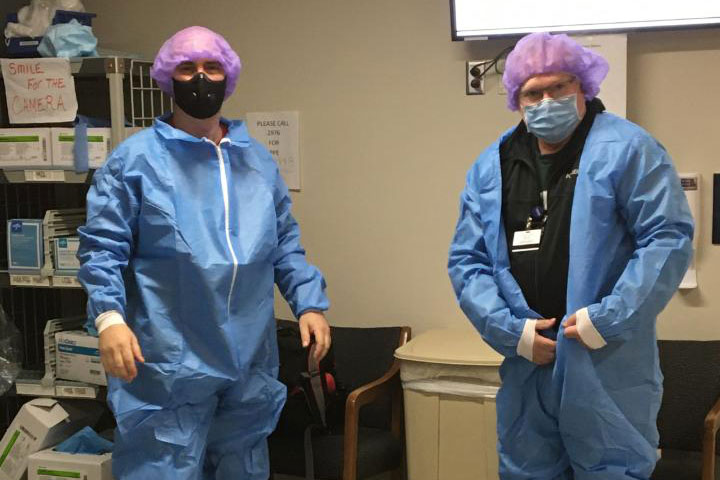They may not be as visible from the front lines, but their toil in the background helps put the “heroes” in “health care heroes.”
The entire IT staff was ‘always on.’
—Nancy Senick, Director, Application Development
Information technology employees work behind the scenes in a relatively obscure way, but their efforts are crucial to the success of UConn Health’s patient care, research, and academic missions. And when the world mostly stopped a year ago, they kept going, and made it so UConn Health kept going.
“We consider ourselves a part of the patient care team,” says UConn Health Chief Information Officer Chuck Podesta. “Everything we do to support our caregivers directly affects our patients’ experience.”
Podesta and members of his leadership team explain how the work of their staff has been helping power UConn Health through all the changes this last year has brought.
During the pandemic, the hospital of course never closed, but neither did many aspects of IT. Who stayed on duty and what were their contributions?

“The security team rolled out multifactor authentication and a number of other technologies to protect the entire institution and enable the ability to work from home securely,” says Carrie Gray, associate vice president for IT security.
More than 360 loaner laptops have been in use.
“Mac and PC field techs have stayed on duty to provide daily technical support,” says Rob Darby, assistant vice president for IT enterprise technology. “IT images, deploys and supports COVID loaner laptops, and has deployed webcams for telemedicine. All of the on-call teams continued 24/7 services and operational activities in the Data Center and in the field.”
“As we all pivoted to a new normal, we ensured that both our patients and caregivers could use virtual tools to connect with our practitioners and Epic training team.” says Laura Marquez, assistant vice president for IT clinical systems. “In November, the Epic analysts, trainers, and quality assurance testing team ensured the success of the new monoclonal antibody therapy build and workflow. In December, many IT teammates were onsite to support the COVID-19 vaccine clinics, and some of the IT RN’s administered COVID-19 vaccinations.”
The building out of surge floors in the University Tower and the Connecticut Tower required many IT teams’ assistance. IT staff helped establish, and continues to provide support to, testing sites and call centers, including but not limited to maintaining temperature stations and security, and helping move critical infrastructure and clinical projects forward.
The Epic Service Desk assists many patients who are already overwhelmed by the pandemic and the use of technology.
—Rob Darby, AVP, IT Enterprise Technology
Meantime, Epic, UConn Health’s electronic health record platform, is vital to UConn Health’s objectives with COVID-19 testing and vaccination.
“The entire IT staff was ‘always on,’ building out creative solutions for drive-thru COVID-19 testing, statewide testing, establishing interfaces with JAX laboratory and pivoting to leverage telehealth visits,” says Nancy Senick, director of application development. “When the COVID Call Center was drowning in paper, my team built and deployed a custom Virus Tracker solution in less than three weeks. Everyone was working with one goal in mind, support the caregivers in any way we can.”
Many know IT as “tech support,” but there’s much more to it. What are some crucial functions of IT that folks may not know about?

“Support means not only fixing a desktop or a laptop, but nightly, hundreds and thousands of automatically executed operations: moving data from one application to another, maintaining databases, applications, etc.,” Podesta says. “And of course there’s a project management component, applying new technology, developing new systems or services or improving existing ones, and introducing new or improving business processes.”
Other functions include securing systems from hackers and helping users get access to systems, as well as improving business processes or introducing new ones.
“This year, we wanted to connect with the patients in a new way, and created a MyChart Patient Experience work group to solicit feedback directly from patients,” Marquez says. “Connecting directly to community members has broadened our perspective and allowed us to collect first-hand recommendations from our patients.”
MyChart is the patient portal in the Epic electronic health record that enables patients to securely access visit summaries, test results, and other medical information, as well as message providers and request appointments.
Although there has been a big impact on our caregivers, the biggest impact is on the patient.
—Dr. Dirk Stanley, Chief Medical Information Officer
“The Epic Service Desk assists many patients who are already overwhelmed by the pandemic and the use of technology,” Darby says. “They reassure them they are not alone and we are here to help with televisits or MyChart support to schedule a test or vaccination.”
IT employees also have been building and enhancing infrastructure, and ensuring the reliable functionality for communications tools such as web conferencing, telephone service, and remote connectivity for the rest of the workforce.
Describe the undertaking of equipping a workforce making an abrupt shift to telecommuting?
“The biggest shift was for our providers and getting everyone trained on MyChart and Zoom so patient care could continue.” Marquez says. “Without any preparation or planning, within two weeks, the training team transitioned from in classroom training to full virtual training.”
Securing devices and systems never intended to be used remotely has been a massive undertaking.
Carrie Gray, AVP, IT Security
“UConn Health purchased new Meraki VPN devices that would support our outer offices with redundant pathways to our main data center,” Darby says. “When we received notification that UConn Health would transition as many as possible to work from home we were on track and ready to deploy over 300 Merkari devices. Hundreds of people were sent home overnight to work remotely using a number of technologies such as Nutanix, Citrix, Thin clients, and VDI. We built 16 Citrix servers to increase capacity and introduced Meraki devices that extend a secure UConn Health network and phone connection allowing staff to work from home. Security has been heightened in response to ransomware and work from home exposures, with umbrella and crowdstrike implementation and two-factor authentication.

“The IT Service Desk provided support to telework employees in a very fast-changing environment. Field techs had to build and deploy a large amount of new equipment while providing as little disruption to our end users as possible.”
Adds Jim McGennis, director of IT project management, “We had to develop techniques to manage distributed teams to keep projects on track, not only the technology but the soft skills to keep our teams engaged while working remotely.”
In your world, it seems success seldom goes noticed, while failures almost always are noticed. What are some successes your staff has had during the pandemic that the rest of us may take for granted?
“We have been able to continue to grow clinical services and bring on many new departments, generating new revenue streams for UConn Health,” Marquez says.
“During the pandemic we transitioned over 7,000 stations and 3,500 IP telephone sets to our new phone system,” Darby says. “Field tech support, both Mac and PC, had to evolve rapidly as new technologies were introduced with the adoption of telemedicine.
For which areas of IT has the pandemic posed the greatest challenges?

“Security,” Gray says. “Securing devices and systems never intended to be used remotely has been a massive undertaking.”
“The ever-changing business needs and competing priorities,” Marquez says. “Whether it be standing up new testing or vaccine sites, to build surge and decontainment units, all while trying to continue to support new business streams as UConn Health grows. We’ve also had to stay on top of all the federal regulations and larger enterprise projects to ensure compliance.”
Describe how IT has evolved in recent years to become so interwoven with the most crucial aspects of health care?
“Although there has been a big impact on our caregivers, the biggest impact is on the patient,” says Dr. Dirk Stanley, chief medical information officer. “The need for the patient to understand technology is becoming more important as we evolve in supporting patient care. This is especially true with the pandemic. Patients need to understand how to use Zoom and access MyChart to visit with their providers, schedule their COVID-19 testing or vaccine, and perform eCheck-in functions. Patients now also have the ability to view most of the information in their medical records on their device. This is light years from where we were even just three years ago, before we implemented Epic.”
“In many ways we have evolved into sort of the welcome committee for new employees,” Darby says. “With the advent of the pandemic, there are so many onboarding functions that have become ‘virtual’ and we are often the first meaningful interaction with the new employees after they accept the job offer. We make sure that they have the appropriate access and training. It is vital that we give the best possible experience for them because it sets the stage for all other interactions.”
“From a project management side we have become very attuned to stakeholder needs and managing new technology implementations to keep up with the evolving field of health care IT,” McGennis says.
“IT handles most of our upgrades with the help from our vendors,” Podesta says. “Building vendor relationships that weave into our collaborative strengths with the business result in successful updates with limited or no business interruption. There are so many of these efforts underway and so many that will continue to occur as a part of our overall strategies to drive cloud and hosted solution implementations.
What can the rest of us do to help ease the burden on IT?
During the last year, all of our teammates have gone above and beyond, tapping into their own resilience, so that we can best serve our caregivers and patients.
—Laura Marquez, AVP, IT Clinical Systems
“Don’t share your devices and passwords with household members, don’t save confidential information to personal devices, and always use caution when clicking links or downloading files in emails,” Gray says. “Provide new hires with their usernames and passwords prior to their Epic training class.”
“Utilize your learning home dashboard available from the F1 button in the Epic application, seek out your super users, and then call service desk for assistance,” Marquez says.
“Be sure to provide as much detail about the problem in the help desk ticket, and include a MRN and a telephone number where you can be reached with best days/times,” Darby says. “Have a precise description of the problem and technologies in use from home: Meraki, Citrix remote, etc. This year, the Service Desk should focus on implementing a self-service portal for non-urgent requests, along with a self-service tool for password reset. Lastly, a true PC life cycle program to keep our PC’s and laptops current.”
“Having a clear, detailed understanding of your needs and your workflows can help save time by directing the request to the right people, and answering questions that might arise when implementing a fix,” Stanley says.
What other aspects of your work should we know about?
“Regardless of whether these are small troubleshooting or major project requests, everyone is able to navigate successfully through our internal technical teams, our vendors and the business to determine impact, resolve issues or to develop new and improved solutions,” Podesta says. “Collaboration also seeds new ideas, innovation and creativity.”
I’m also amazed by the level of business knowledge we have to bridge the gap between business and technical disciplines.
—Chuck Podesta, Chief Information Officer
“We can leverage our Citrix environment to build out our solutions with little or no expense to our customers,” Darby says. “We’re adjusting and modifying support models (such as with Natus and Tidal) with our customers to ensure we can lift unnecessary burdens on the business while also building in technical efficiencies.”
“To improve business efficiencies and support our finance department, we provide our users with data visibility, access to transactional feeds, and improved abilities to update, delete or resubmit department files. Our teams have been an essential part of business transition, training and ongoing solution monitoring. We bridge the gap in software versions to maintain smooth business functionality, and have built extensive auditing capabilities to support internal and external auditing requirements.” Marquez says.
Podesta adds, “I’m also amazed by the level of business knowledge we have to bridge the gap between business and technical disciplines. Business-specific external communications are often being monitored by members of our team to keep up on any business changes that could impact the solutions we support.”
“Developers are extending their capabilities to include business specific competencies related to the businesses they support. These competencies improve the overall success of testing, troubleshooting, and solution design,” Senick says. “We’re finding data quality and potential processing issues. Proactive monitoring and review of systems and files reduces interruptions in service.”
“During the last year, all of our teammates have gone above and beyond, tapping into their own resilience, so that we can best serve our caregivers and patients,” Marquez says. “We are proud to be part of the solution.”



